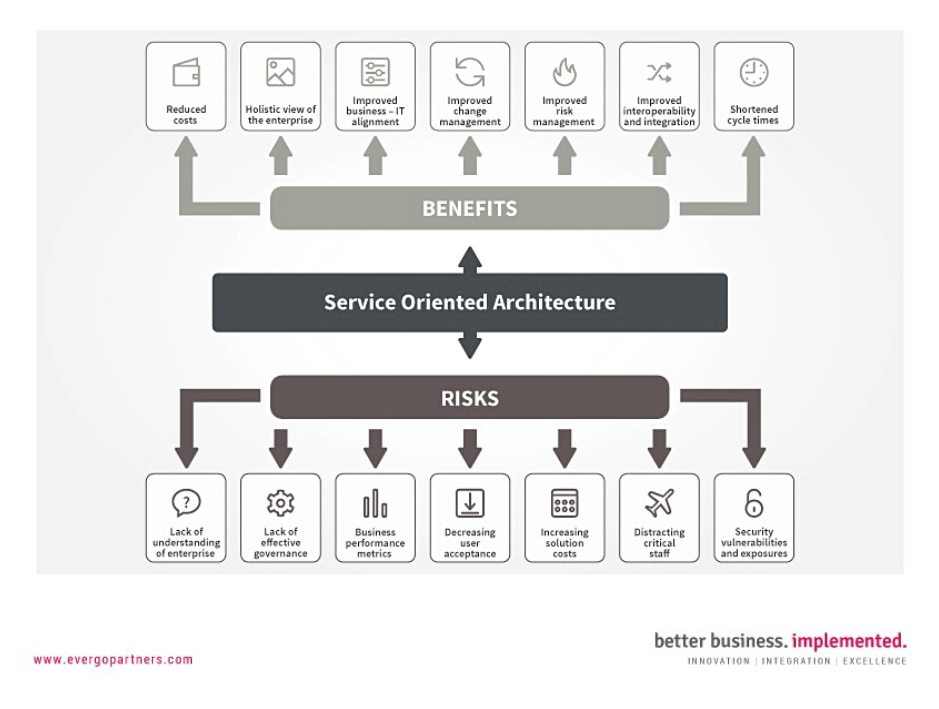Overview
The most fundamental challenge for most of organizations today has been an alignment between business and IT within an organization. The organizations struggle with the question of how to justify the IT budget, especially when there seems to be very little evidence stating that the supporting function of IT is adding sufficient value to the bottom line of the organization, especially in non-IT businesses.
Here comes the Enterprise Architecture (EA) and Service Oriented Architecture (SOA).
Both EA and SOA aim to address the issue of alignment between business and Information Technology solutions. The alignment should be achieved at both the strategy and technology levels – EA provides alignment at the strategy level and SOA provides alignment at the technology level. It should be remembered though, that it is not just about alignment – it is more about collaboration. Business and IT must collaborate to create an environment in which investment in IT and delivery of IT services reflect business priorities. IT and business must collaborate as equals. Business provide investment and seeks solutions from IT, and IT delivers IT services, and also influences Business change by identifying opportunities available from technology changes.
Adoption of EA and SOA introduces several benefits as well as some risks for an organization. They are listed below.

Enterprise Architecture Benefits
There are several key benefits that EA can provide to an organization. The most important ones seem to be the following:
- Reduced costs related to reducing duplication and overlapping in technologies and processes, reusing components, integrating systems, increasing standardization, and rationalizing procurement.
- Providing a holistic view of the enterprise.
- Improved business – IT alignment by defining a common business vision by EA and performing governance over projects for EA compliance.
- Improved change management achieved by documenting the current state, the target state, and transition plans to EA.
- Improved risk management through providing a description of the current state for preparing an enterprise for unplanned changes, defining common standards, guidelines and principles that the IT organization can use for decision making, and providing information to projects for assuring EA compliance.
- Improved interoperability and integration, thanks to increasing collaboration between organizational functions with the aid of integrated IT systems.
- Shortened cycle times related to reuse and standardization.
Enterprise Architecture Risks
With the EA benefits there come some risks as well. Some of these are:
- Lack of understanding of enterprise architecture among stakeholders. The stakeholders will not support EA, if they don’t participate in the EA program. Also, when the EA is defined but then is largely ignored by IT managers, solution architects and other stakeholders, the adoption rates will be low.
- Lack of effective governance. If governance processes are not established from the start, there is a risk that everyone will have developed their own working style, that there are no monitoring and audit tools available to guide the architectural design.
- Business performance metrics that create counter-productive results. When people know they are being evaluated by metrics it dramatically changes their behavior. Very often they try only to hit the targets instead of being truly productive.
- Decreasing user acceptance. Users often complain that common solutions are less adapted to the needs of their business unit. Departments often like to control their silo-solutions completely. When they are forced to transition from silo to common solution, they are often unhappy.
- Increasing solution costs. EA programs often over-engineer the solutions. Enterprise architects tend to recommend enterprise-class solutions, while they may be overkill for the business problems at hand.
- Distracting critical staff. Stakeholders often complain that EA is cumbersome. Meetings, document reviews and training can distract critical staff from their core business responsibilities.
- Security vulnerabilities and exposures. In theory, EA should provide common security frameworks that reduce enterprise security risks. In practice, enterprise architects are seldom security experts and tend to keep away from security issues. Moreover, SOA may also complicate security and introduce new risks, due to several factors, such as legacy application’s security model, services operating across organizational boundaries, data traversing insecure networks, etc.
Conclusion
Implementing EA and SOA can be beneficial for organizations. But still, we have to remember that with benefits come risks (some of them mentioned above). Even after implementation, the long-term value cannot be guaranteed. Moreover, there are so many factors affecting the realization of benefits, that pointing out just EA or SOA as a sole benefit contributor can be difficult. Some practitioners even say that with all the benefits that can be potentially granted by EA/SOA, there is one major risk that comes along: the risk that EA/SOA will not be properly adopted across the organization. And it’s hard not to agree with that notion.



